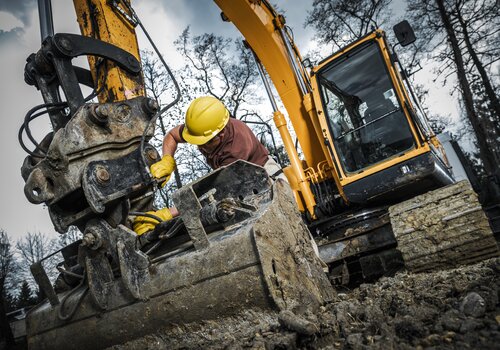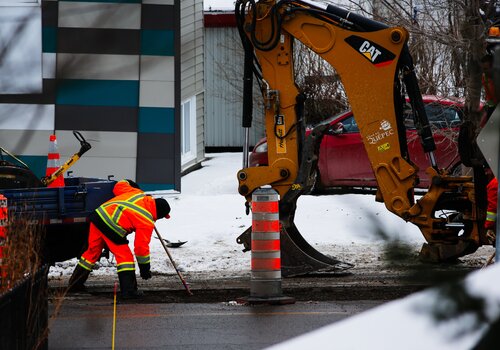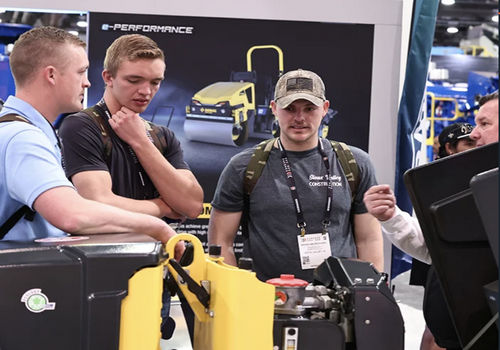Whether pumping concrete to a high-rise building, bridge or a backyard patio, choosing the right concrete pump to get the mix to the jobsite is a key consideration that greatly impacts project costs and productivity. We asked representatives of two concrete pump manufacturers to share their expertise in selecting the right pump for the job.
The two most common types of concrete pumps to choose from are truck-mounted concrete pumps and line pumps, often referred to as trailer-mounted concrete pumps. According to Mike Newcomb, sales and marketing Manager for Reed Concrete Pumps & Shotcrete Equipment, truck-mounted pumps are typically used in high-volume applications such as high-rise construction. A truck-mounted concrete pump has a large engine and a remote-controlled articulating arm or boom to place concrete accurately. The cost of these pumps ranges from $375,000 to more than $1 million dollars.
Line pumps or trailer-mounted pumps are commonly used to pump shorter distances. “Trailer-mounted or line pumps are typically used in low to mid-volume applications,” says Newcomb. Within this category there are more specific applications that use line pumps such as auger cast piling and shotcrete work. They are far less expensive than truck-mounted pumps with costs ranging from $90,000 to $175,000.
According to Newcomb, structural shotcrete walls represent a growing application for trailer-mounted pumps. They save time and are proving to be a cost-effective alternative to cast-in-place concrete walls. “The walls are perfect,” says Newcomb. “You don’t have to do rework like you do with form and pour work.”
A third type of pump, called a stationary pump, is used in specialized situations. Guilherme Zurita, divisional director of Concrete Technology for Liebherr says that if the boom reach is not long enough for placing the concrete such as on some high rises, foundation piles, very long length pours, underground, etc., a stationary pump should be used. Liebherr stationary pumps range from 11,464- 12,897 pounds and are capable of pumping from 100- 200 cubic yards per hour. “High powered stationary pumps will be placed at a strategic position at the jobsite, and will remain there for long periods of time pumping concrete, says Zurita. “There are cases when the stationary pump needs to be attached to a foundation machine, like the Liebherr crawler pumps that work attached to a drill rig, pumping concrete simultaneously as the foundation is dug by the drilling machine.”
Below are some questions to help you narrow down your choice of a concrete pump that will work best for the project and for your business.
What is the distance from the concrete delivery area to the placing location?
Zurita says the distance from the concrete delivery area (where the ready-mixed concrete trucks will park) to the placing location, will determine the size of the boom to be used on a truck-mounted concrete pump. “Horizontal distances as well as above or below-ground spots can be reached by a concrete pump boom, making this equipment not only flexible but an essential tool within the construction industry,” he says. The vertical reach of Liebherr truck pumps ranges from 77.8 feet to 161.1 feet.
Review manufacturer spec sheets to find the maximum horizontal and vertical pumping distances for line pumps.
Can the pump handle your concrete mix?
Some types of trailer-mounted pumps are limited in the types of concrete mix they can handle. This is measured by the maximum aggregate size they can handle. “While ball valve style trailer pumps are inexpensive, the maximum rock size they can handle is 3/8 inch pea gravel,” says Newcomb. For this reason, they are used primarily in regions where this is a lot of low-volume, small-rock concrete work, such as California and Florida. Other line pumps can handle concretes containing larger coarse aggregate (3/4- to 1 1/2-inch rock). Applications for heavier concrete include concrete slabs, shotcrete and other concrete structures.
What footprint is needed for setup?
According to Zurita, another important consideration in concrete pump selection is the footprint needed for the equipment set-up. “There are many jobs that are limited in space such as busy urban areas,” says Zurita. “Contractors should look for a pump that uses the least area as possible, yet is still able to reach the desired pouring spots.”
Are there emissions requirements to consider?
Due to stricter emissions requirements on diesel engines, Reed Concrete Pumps is seeing greater interest in electric-driven and gasoline-powered machines. Electric models are common in underground construction or industrial applications. Gasoline-powered concrete pumps are also trending upward. “Customer love the gasoline-powered concrete pumps because they are cheaper to purchase than diesel units,’ says Newcomb.
What are the maintenance costs?
“Ease of maintenance and wear parts prices are a concern for customers,” says Zurita. Some additional features to evaluate are the simplicity of the design, accessibility to components that need to be cleaned or maintained, the quality of materials, warranty and reputation. According to Zurita, cleaning and maintenance of the pump is paramount. “Once the concrete is hardened inside the pipes or any other element of the machine, costs of repairs can easily skyrocket.”
How does the concrete pump improve safety?
Zurita believes that safety will always be important to customers. “Our new products to be released in the USA will have a stability support system named XXA already embedded in the machine,” he says. “This system allows for greater stability while pumping.”
Is the concrete pump easy to operate?
With labor shortages expected to continue, manufacturers are doing what they can to make concrete pumping machines easier to operate. Liebherr uses electronic solutions where they are needed and to make the operation simpler. The control panel is very simple and intuitive, with three operation modes that make easy for the operator to get out of difficult or even fail situations of the machine. At Reed Concrete Pumps, the controls and readouts make it easier to troubleshoot problems with the machine. Take advantage of equipment training offered by the manufacturer and/or dealer. Truck-mounted concrete pump operators need to evaluate whether the ground conditions are stable enough for the machine to operate, need to stay clear of overhead power lines and determine if the mix is suitable for the pour. “There are times when the ready-mix truck should be rejected because the concrete could not be pumped,” adds Zurita.” For the small trailer mounted line pumps that do not have extending outriggers or an articulating boom, the pipeline “line” lays on the ground until the concrete is placed with the placing hose or nozzle.
With the answers to these questions and more detail about your concrete pumping applications, your manufacturer or dealer can guide you to make the best decision for your business.
Concrete Pump Suppliers to Consider
|
Truck-Mounted Boom Pumps |
||||
|
|
Range |
Vertical Reach |
||
|
10 models |
33X-5ZZ: 105 feet 7 inches 37X-4R: 119 feet 9 inches 38X-5ZR: 123 feet 4 inches 40X-5ZR: 130 feet 2 inches 42X-5RZ: 136 feet 2 inches 43X-5RZ: 138 feet 9 inches 48X-5RZ: 155 feet 10 inches 52X-5RZ: 167 feet 11 inches 57S-6RZ: 184 feet 5 inches 57X-6RZ: 184 feet 5 inches
|
|||
|
Liebherr |
6 models |
36 XXT: 117.5 feet 37 XXT: 120.7 feet 38 XXT: 121.7 feet 42 XXT: 135.2 feet 47 XXT: 151.6 feet 50 XXT: 161.1 feet |
||
|
Putzmeister-Member of Sany Group |
14 models |
20Z-Meter: 63 feet 10 inches 28Z-Meter: 89 feet 7 inches 31Z-Meter: 101 feet 8 inches 33Z-Meter: 105 feet 2 inches 36Z-Meter: 116 feet 10 inches 38Z-Meter: 121-feet 9-inches 38Z-5-Meter: 123 feet 39Z-Meter: 125 feet 8 inches 40Z-Meter: 128 feet 3 inches 42Z-Meter: 131 feet 3 inches 47Z-Meter: 151 feet 3 inches 51Z-Meter: 164 feet 56Z-Meter: 180 feet 10 inches 63Z-Meter: 203 feet 9 inches |
||
|
Sany |
4 models |
SY38 Z5: 124 feet 6 inches SY47 RZ5: 154 feet 2 inches SY56 RZ6-200: 183 feet 7 inches SY66 RZ6: 215 feet 2 inches
|
||
|
Schwing |
17 models |
S 20: 63 feet 9 inches S 28 X: 90 feet 11 inches S 31 XT: 99 feet 11 inches S 32 X: 104 feet 11 inches S 36 X: 115 feet 6 inches S 36 Rev: 115 feet 2 inches S 38 SX: 122 feet 5 inches S 38 SXG:122 feet 5 inches S 39 SX: 127 feet S 43 SX: 149 feet 7 inches S 47 SX III: 151 feet 3 inches S 52 SX: 170 feet 7 inches S 55 SX: 178 feet 8 inches S 58 SX: 187 feet 9 inches S 61 SX: 197 feet 1 inch S 65 SXF: 210 feet 8 inches
|
||
|
Trailer-Mounted Line Pumps |
||||
|
Manufacturer |
Range |
Maximum Output-Rod Side |
||
|
2 models |
TP 50: 54 |
|||
|
Putzmeister member of Sany Group |
15 models of Thom-Katt Trailer Mounted pumps |
P 715 TE – SE: 18 P 715 TS – SD: 18 P 718 TE – SE: n/a P 718 TD – SD: n/a SPM 715 Synchro” n/a TK 7: 7 TK 20: 17 TK 40 TIER 4I: 40 TK 40 Tier4f: 40 TK 50 Tier3: 54 TK 60 HP Tier3: 60 TK 60 HP Tier4F:60 TK 70 Tier3: 74 TK 70 Tier4F: 74 |
||
|
Reed Concrete Pumps |
3 series : Series A “Rockmeister” Series B Series C |
A-30: 30 A-30HP: 30 A-40HP: 40 B-20:20 B-50:50 B-50HP:50 B-50HPS:50 B-60:60 B-60HP:60 B-70:70 B-70HPS:70 C-50SS: 54 C-70S:70 C-70SS:74 C-90 H.V.: 90 C-90 H.P. 74 |
||
|
Schwing |
|
SP 305: 30 SP 500: 45 SP 750-15: 50 SP 750-18: 70 SP 1000 HP: 35
|
||
|
Stationary Concrete Pumps |
||||
|
|
Range |
Maximum Output -Rod Side cubic yards per hour |
||
|
Liebherr |
5 models |
|
||
|
Putzmeister member of Sany Group |
BSA Series includes 8 models including both electric and diesel |
BSA 2111 HP E: 124 BSA 2109 H D5: 133 BSA 2109 H D5: 124 BSA 2110 HP D5: 133 BSA 14000 HP D4 7”: 110 BSA 14000 HP D4 8”: 133 BSA 14000 HP E: 116 BSA 14000 SHP D5: 94
|
||
|
Schwing |
8 models over 10,000 pounds |
SP 1250: 95 SP 2000: 118 SPTM 1000: 119 SPTM 1250:118 SP 7000: 148 SP 7500: 88 SP 9000: 149 SP 9500: 118
|
||












